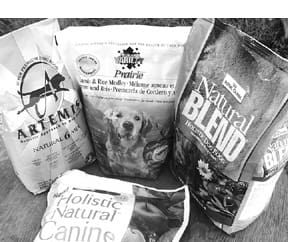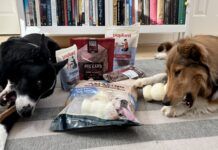A few months ago, the owner of a small, premium pet food company remarked to me, “If the giant food companies ever started using top-quality ingredients – the kinds of things that are in your ‘Top Dry Foods’ selections – all of us ‘little guys’ are going to be out of business.”

Actually, it has begun; the big dogs of the pet food industry are starting to develop products that contain the sorts of ingredients that Whole Dog Journal has celebrated for the past five years – things like fresh, whole meats, vegetables, fruits, and grains; organically raised meat and poultry; healthful herbs; and natural colloidal trace minerals.
Fortunately for all the small makers of premium foods, the ones who have been committed to achieving truly excellent products for years, the giant food conglomerates have not really put all the pieces together – yet.
Take Hill’s Pet Nutrition’s latest launch, for example. Hill’s has identified a fast-growing niche within the $12.4 billion pet food market in the US: discriminating pet owners who want “natural” foods for their beloved animal companions. Hill’s cites some statistics on its Web site that explain its interest in the “natural” niche: The number of “natural” products increased by 38 percent in 2001; the largest natural food supermarket chain is growing at a 20 percent clip; sales of natural and organic foods are growing at an 18 percent annual rate and are projected to surpass $17 billion this year.
Given these facts, Hill’s came up with this: Science Diet Nature’s BestTM, a line of “all-natural” dog (and cat) foods with “high quality, naturally preserved ingredients.” Nature’s Best does contain whole beef, peas, and carrots. That’s a huge step in the right direction for a conglomerate food maker – even if these ingredients are way down in the 7th, 9th, and 10th places, respectively, on the list of ingredients.
Small companies still the best
As I hinted above, WDJ’s “Top Dry Food” makers needn’t be too worried about efforts like Hill’s – yet. Nature’s Best is a better product than Purina’s effort (the execrable “Beneful”) to appeal to the “granola and tofu” segment of the pet-owning population, but it’s not “top-quality” (see comparison charts, end of story).
Nevertheless, the wheels are turning. The pet food industry leaders have finally realized there are millions of people who are willing to pay a lot for foods that can help keep their animal companions as healthy as possible for as long as possible. The savvy marketers among them have already taken aim on us free-spending health nuts; witness the plethora of new products with the words “holistic” and “natural” in their names, or at least in giant letters on the front of the bags.
Small pet food companies that are committed to producing top-quality foods have one big advantage over the corporate giants: Their production runs are small enough that they can formulate foods using ingredients of amazing quality, and the consumers most committed to their dogs’ health will pay whatever these foods cost. For the present, these are the companies who are making the healthiest foods. (The small companies may not make the most consistent products, however; see “Made in a Secret Location,” WDJ January 2003.)
But (as the pet food company owner I quoted earlier suggested), if some of the bigger companies applied their ingredient purchasing power, self-owned and -operated manufacturing plants, and giant advertising budgets to work on products that contained even just good-quality ingredients, they could pose a real danger to the roughly 13 percent of the pet food market collectively served by all the little companies. Currently, that’s what’s left of the US pet food market-share pie after Nestlé Purina takes its 30 percent; Iams takes its 14 percent; Hill’s, MasterFoods USA, and Ol’ Roy take 10 percent each; and Nutro takes its 5 percent.
It’s worth it
Because virtually all the foods that are on our “Top Dry Foods” lists, past and present, are represented among that tiny 13 percent market share, you can expect them to be more difficult to find. Recently I was amused by an honest counterperson – obviously a new hire – at a really great independent pet supply store, where I was asking about an obscure new food. She said, “Is that a dog food you’ve seen on TV? Because if you’ve seen it on TV, we don’t have it. I’ve never heard of any of the foods we have here,” she finished ruefully. Let me just say, “That’s our kind of pet store!”
By and large, the giant chain pet supply stores carry few foods we consider to be really good. (I got in trouble last year when I said none of the giant chain stores carry any of our selections. A few carry a few.) In general, you have to look for independent pet supply stores owned by really knowledgeable dog people. Many of the makers of the foods we highlight will sell directly to pet owners, sometimes splitting shipping costs. In other cases, I’ve heard of people approaching their local groomer, breeder, or even health food store, and asking the store owner to carry one or two of the foods they like best. If the buyer can tell the store owner that he or she will buy a certain amount of the food monthly, and convince X number of their friends to buy that food, too, the store owner may be able to expand his inventory to include that food.
Expect to pay more for top-quality foods – maybe two or three times more than you may have paid for lesser-quality products. Top-quality foods are necessarily expensive because top-quality ingredients cost more than food fragments cast off from the human food industry.
What we did and didn’t do
We did something new this year. Instead of essentially re-reviewing many of our past selections, we concentrated on finding products that we’ve never listed before. All of our past picks (listed below left) still meet our selection criteria (which is listed directly below). As you’ll see, we’ve “deselected” only one of our past picks: Best In Show, whose maker has gone out of business.
In every case, all the different varieties or “flavors” of a given dog food line are also approved. For example, we like the entire “Prairie” line of foods made by Nature’s Variety, not just the lamb-based food. However, some manufacturers (such as Royal Canin) make several different lines or “families” of foods, targeted to very different price points and formulated accordingly. Unless we indicated an additional line or family was approved, assume it is not.
• The following are things we did NOT do when we selected our past and new “Top Dry Foods.”
• We DID NOT reject any of our past selections. All of our past selections (listed at end of story) still meet our selection criteria.
• We DID NOT conduct lab tests to make sure the “Guaranteed Analysis” printed on the label accurately reflects the contents; that’s the job of state feed control officials.
• We DID NOT inspect manufacturing plants or verify ingredient claims. For example, some companies say they use organically grown foods, or human-grade ingredients. At some point in the future, we’ll be asking manufacturers to show us proof that these ingredients are what they say they are. We’ll keep you posted.
• We DID NOT select foods on the basis of protein or fat content; more is not always better. Some dogs need more; some dogs need less. It’s a good idea to note the protein and fat content of any food that seems to suit your dog, as well as the levels in foods that distress him. This information can help you make future selections.
• We DID NOT examine every food on the market. That would be impossible! You may find a food that looks as good or better than ours. Good for you! Send us some information about it; we’d love to share.
• We dID NOt rank-order the foods. They are presented in alphabetical order.
Choose three or four
We can’t say it enough, so we’ll say it in capital letters: THERE IS NO SINGLE “BEST” FOOD. We still like all the foods we’ve chosen in past years, and we like all these newer foods, too.
To determine which ones might be most appropriate for your dog, you will have to try a few. All dogs are different; some do better on higher-protein foods, some do better on lower-protein foods. Some can’t digest chicken. Some break out if they eat wheat. Try a likely candidate for a month or two. If your dog has problems, it doesn’t mean it’s a “bad” food; it just disagrees with your dog. Give the food away and try another one!
If, on the other hand, your dog has had chronic health problems, such as infected ears, itchy paws, or runny eyes, and these symptoms clear up, you’re on the right track. A good dog food will contribute to a healthy coat, good energy level, balanced temperament, and flawless health.
Don’t feed only one food for the rest of your dog’s life, either. That’s a surefire way to help him develop food allergies or intolerances. Any nutrient deficiency, excess, or imbalance expressed in a food can become entrenched in your dog’s body if that’s all he’s fed for years on end. (See “Variety Is the Spice of Life,” WDJ June 2001, for more information about the importance of occasionally switching foods.)
Also With This Article
Click here to view “Additional Whole Dog Journal 2008 Approved Dry Foods”
Click here to view “Focusing in On The Main Ingredients in Commercial Dog Foods”
Click here to view “20 Dry Dog Food Shopping Tips”
———-
Nancy Kerns is editor of WDJ. Dry food reviews have appeared in each February issue since 1998.






